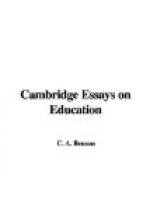manifest that the proposed Register could not succeed.
In the Annual Report of 1905 the Council stated that
under existing conditions it was not practicable to
frame and publish an alphabetical Register of Teachers
such as appeared to be contemplated in the Act of
1899. In June, 1906, the Board of Education published
a memorandum stating the reasons which had led it
to take the opportunity afforded by impending legislation
to abolish the Register, and in the Education Bill
of 1906 a clause was inserted which removed from the
Consultative Committee the obligation to frame a Register
of Teachers. This clause was strongly opposed
by many associations of teachers. It was urged
by these bodies that although one scheme had failed
yet a Register was still possible and desirable.
It was held by many that the task assigned to the Registration
Council had been an impossible one since the conditions
of supervision and control imposed under the Act of
1899 left the Council very little freedom and wholly
precluded the establishment of a self-governing profession.
The general opinion seemed to be that any future Register
must be in one column avoiding any attempt to divide
those registered into different classes and that any
future Council must be as independent and widely representative
as possible. This opinion found expression and
official sanction in a memorandum issued by the Board
of Education in 1911 after several conferences had
been held for the purpose of promoting a new registration
scheme. The memorandum stated that: “It
should not be so much the kinds of teachers likely
to be most rapidly or easily admitted to the Register
that should specially determine the composition of
the Council but rather the larger and more general
conception of the unification of the Teaching Profession.”
This new and wider idea served to govern the formation
of the Teachers Registration Council which was established
by an Order in Council of February, 1912. The
body constituted by this Order consists wholly of
teachers and includes eleven representatives of each
of the following classes: the Teaching Staffs
of Universities, the Associations of Teachers in Public
Elementary Schools, the Associations of Teachers in
Secondary Schools, and the Associations of Teachers
of Specialist Subjects. The Council thus numbers
forty-four and it is ordered that the chairman shall
be elected by the Council from outside its own body.
At least one woman must be elected by each appointing
body which sends more than one representative to the
Council provided that the body includes women among
its members. It will be seen that the constitution
aimed at forming a Council wholly independent and
thoroughly representative. This quality was further
ensured by the establishment of ten committees, representing
various forms of specialist teaching and providing
that any conditions of registration framed by the
Council should be submitted to these committees before
publication.




